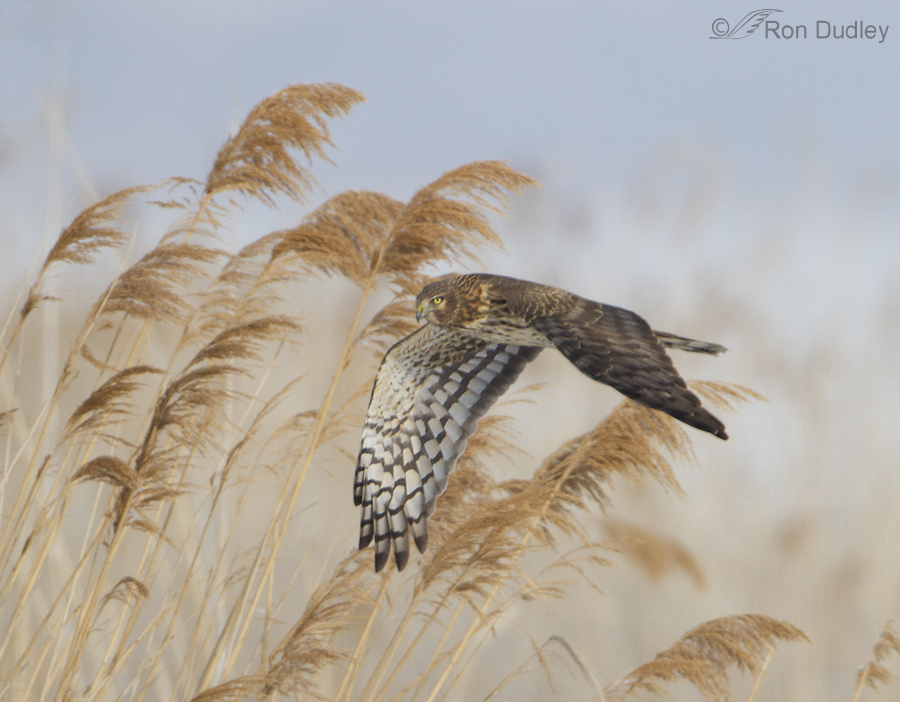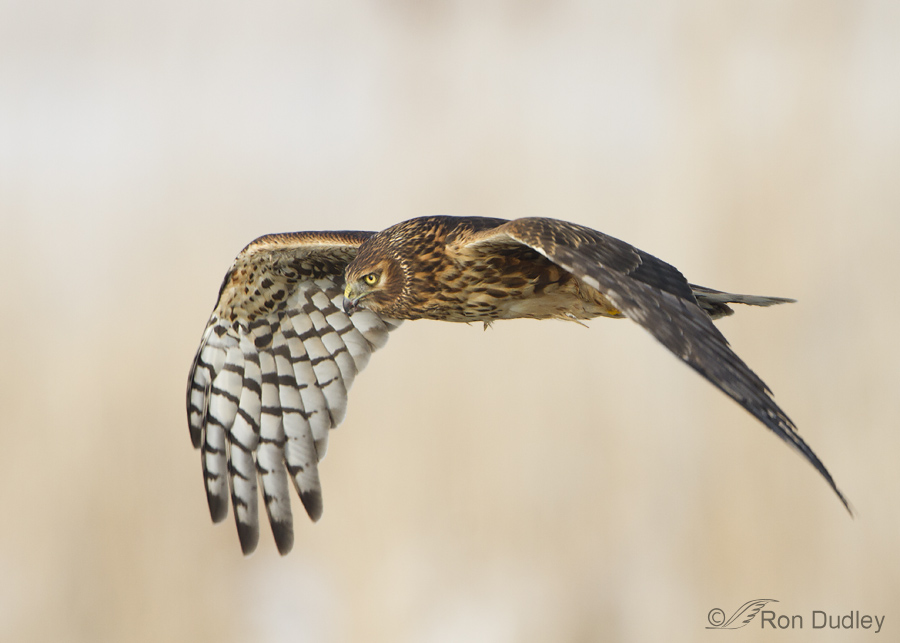I’ve said before that plain sky backgrounds in flight shots aren’t my preference. But habitat in the background provides its own challenges for the photographer.
With my Canon 500 mm f/4 lens, attached 1.4 teleconverter and the 1.6 crop factor of the Canon 7D I’m effectively shooting at 1120 mm (500mm x 1.4 x 1.6) which gives me extremely shallow depth of field. For example, if I’m 50′ from my subject and shooting at f/6.3 my total DOF for good sharpness is about 4″ (which explains part of the reason why sharp focus is so critical with telephoto lenses). My lens is known for the pleasing bokeh it produces when background elements are out of focus but I don’t get many “bird in habitat” (BIH) flight images where the setting elements are relatively sharp because of that lack of DOF. Larger birds in particular just don’t often fly that close to vegetation and when they do it’s difficult to keep focus locked onto them in flight because the background is so close.

1/1600, f/6.3, ISO 640, Canon 7D, 500 f/4, 1.4 tc, not baited, set up or called in
This is one of those fairly unusual times that I was able to get the vegetation behind a bird in flight relatively sharp because the juvenile male (yellow eyes) Northern Harrier flew so close to the phrags that its right wing must have almost brushed them.
I like seeing images like this but there’s a couple of potential tradeoffs, depending on individual tastes. With the vegetation so close and fairly sharp there’s the danger that it will distract from the bird. Then the decision must be made about how to crop the image. Cropping tight focuses the viewer’s attention on the bird but minimizes the habitat that you may want to emphasize to some degree.

1/1250, f/6.3, ISO 500, Canon 7D, 500 f/4, 1.4 tc, not baited, set up or called in
Here’s the other extreme. This image was taken within a half hour of the first one and in the same habitat (phragmites and snow) but the phrags are far enough away that they’re a complete blur. In addition the tight crop on the harrier focuses our attention almost entirely on the bird. And notice the DOF here – that softness of the wingtips isn’t motion blur.
Two shots, same gear, same general habitat, very similar settings and almost identical flight postures and light. But the “styles” of the two images are very different and that difference is largely due to DOF and distance from the background elements, though I was also somewhat closer to the bird in the second image.
Ron
Note: Here’s a link to an excellent DOF calculator. I’ve provided this link before but some may have missed it.


Both shots are very nice, but I prefer the second one, because I do find the phrags distracting. It’s much harder (for me) to see the details of the bird with the busy background. Northern Harriers sure are gorgeous birds.
I LOVE Patty’s comment about the phragamite/feather similarity. I had seen it, but not registered it. Thank you both.
Wonderful shots and isn’t there room for both in the eyes of the viewer and shooter as well? Variety is wonderful! thanks for sharing your great talent Ron!
The texture and shape of the phragmites are very feather-like…complement colors and textures of the bird…nice!
I agree. Thanks, Patty.
Phragmites provide a challenge for photographer and bird of prey…Flying, hunting, nabbing prey in that tangle of vegetation must be difficult…especially if bent and matted down by snow and ice…another reminder if how tough it for these magnificent birds.. the bent phragmites in the first image gives a sense of battling a head wind…even if it isn’t really so….like it! Recently got Jerry Liguori’s book, HAWKS FROM EVERY ANGLE…LOVE it! Best, most common sense, practical format I’ve ever seen..Wish I’d gotten it a LONG time ago! Will no longer refer to every high flying hawk silhouetted against the sky as a “red-tailed”…Jerry, you’re the best!!!
Patty, Jerry’s an extremely knowledgeable raptor authority and author but he’s even a greater guy. Glad you like the book!
Patty — Thank you, that is great to hear!!!!!
Ron — I want to agree with you, but I have to admit that I’m better at raptors than I am at being a great guy…hee hee. You and Shyloh are great guys. I try to be, but for some reason, my reputation is as an unsociable jerk. Feel free to disagree, my goal is to get Mike Shaw to like me.
Jerry, If you’re an “unsociable jerk” you’ve sure hidden it well from me in the time I’ve spent with you.
I think I’m a great guy and hilarious!!! Hee hee, thanks Ron.
My plans to become a “wonderful person” never panned out….sounds like Jerry made it, in spite of his protests to the contrary…Mike Shaw: You’d better like(make that ADORE) Jerry Liguori….or answer to me (Worlds greatest wannabe Sharpie/coopers sorter outer to be)…FYI, I’m dangerous not only to myself, but to others. I’ve got Jerry Liguori under my wing!
Ha! Jerry might not know much about birds, but he IS a good judge of character: Ron and Shyloh are indeed the greatest! Patty, I gather you haven’t yet met Jerry? Shared a ridge top, a golf course, a hike or a day in the car with him? You’ve got something to look forward to! Truth be told I love Lig, but don’t tell him that… 😉
My lips are sealed (pretty chapped, too!)…
Patty’s got my back!!!
I was just teasing Mike of course, but thanks Mike. Besides Ron and the ever-loveable Shyloh, Bryce and Mia are right up there!
Of course Mia is…she’s Ron’s “half-side”!
As I understand it, you used the camera’s crop factor. If you had not, you would have captured a smaller image, Could you not have taken the full frame picture and cropped in post production, and enlarged with the same results?
Mark, I had no choice but to “use the camera’s crop factor” as the 7D isn’t capable of switching from “cropped” to full frame. But even if I had a full frame camera, everything else being equal I’d have lost image quality from the heavier crop. The first image here is already cropped to 50% and that’s generally about as many pixels as I will lop off.
It looks like he’s looking directly at you in the first one so I think that it draws the viewer in to the bird more than if he was looking elsewhere. I don’t think a bird always has to be making eye contact with the photographer or viewer to be a great shot, but in this case, I think it eliminates the potential problem of background competing with the foreground. Both are beautiful shots of a most beautiful bird.
Thanks, Sharon. And I agree that you don’t always need “eye contact”. In fact often in behavioral shots particularly, eye contact can be undesirable. I do like to at least be able to see the eye, though. You make a good point.
Holy….WOW! I love these shots!…..Bravo!
Tim
“Holy…Wow”. Loved that, Tim. A new combination of words for me…
Thank you.
Just lovely – I can almost hear the wind!
Thanks, Alison. Having grown up in western Montana the sound of wind doesn’t have a lot of appeal for me… Actually, the wind wasn’t blowing here – the frags are leaning from their own weight and from having been previously bent by the weight of snow and heavy frost.